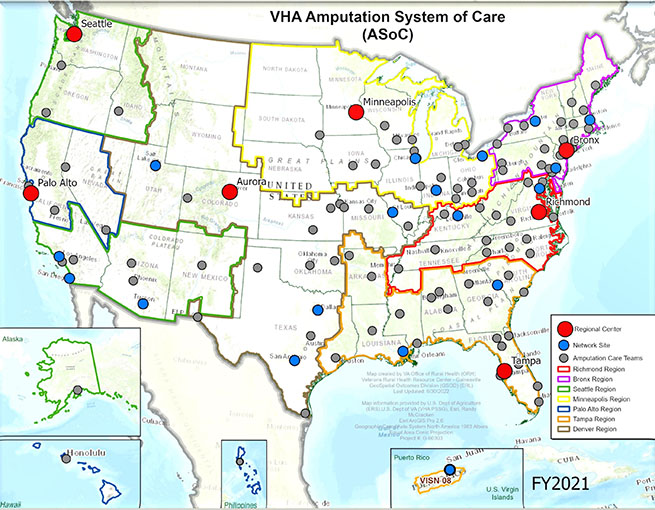Rehabilitation and Prosthetic Services
Amputation System of Care (ASoC)
The Amputation System of Care (ASoC) provides specialized expertise in amputation rehabilitation incorporating the latest practices in medical rehabilitation management, rehabilitation therapies, and advances in prosthetic technology. It is a system of care designed to provide Veterans access to the full continuum of care.
Vision: To be a world leader in providing life-long amputation care.
Contact list for ASoC Specialty Center Coordinators

News and Stories from the Amputation System of Care
Amputation Specialty Clinic Team
Your Amputation Specialty Clinic Team is an interdisciplinary team who will assess your clinical needs and create a treatment plan for amputation-related care such as prescribing appropriate prosthetic devices, evaluating the fit and function of all prosthetic devices and conducting annual follow-up ensure continuity and lifelong management based on clinical care needs. Your core team would likely consist of the prescribing clinician, a therapist with experience in limb loss rehabilitation and a prosthetist, the individual specializing in limb fabrication.The prescribing clinician is responsible for:
- Completing the prosthetic prescription,
- Assuring medical appropriateness and readiness for prosthetic use,
- Addressing amputation-specific medical conditions, and
- Referring the Veteran for additional services such as nutrition and food services, whole health coaching, mental health services, adaptive sports and recreation, driver rehabilitation and so much more.
- Providing recommendations for prosthesis use and rehabilitation needs,
- Providing instruction of a home exercise program,
- Assessing and issuing equipment, and
- Providing functional skills training with the prosthesis.
- Providing clinical expertise in prosthetic components and function, and
- Performing adjustments and alignment changes to prostheses.\
Athletic and Special Event Opportunities
The Amputation System of Care (ASoC) and the National Veterans Sports Programs & Special Events (NVSP&SE) partner to ensure our Veterans living with limb loss are aware of the opportunities the various events provide. From the Sports4Vets Throwdown to the National Veterans Disabled Golf Clinic, there are multiple ways for participants of all interest and activity levels to take part in adaptive sports and special events.- National Veterans Sports Programs & Special website
- National Veterans Sports Programs & Special Events Fact Sheet
Peer Support Program
The VA Amputation System of Care collaborates with the Amputee Coalition in training Veterans living w/ limb loss to become Certified Peer Visitors as these individuals understand the challenges of the recovery process. Support can also be in the form of a support group. A support group offers an opportunity for the individuals involved to share feelings and experiences and often support groups include educational opportunities by organizing topics of interest helpful to the group. To learn about amputation & prosthetic care, request support for people living with limb loss and locate a support group near you visit the Amputee Coalition Website.
Osseointegration
In January of 2022, the Veterans Health Administration, led by the Amputation System of Care, began offering the FDA approved Osseoanchored Prostheses for the Rehabilitation of Amputees (OPRA™) Implant System for use in patients with above knee (transfemoral) amputations. Where this procedure is not for all people living with limb loss at the transfemoral level, it may be appropriate for those who have experienced amputation due to trauma or cancer and for those who have or are anticipated to have rehabilitation problems with or cannot use a conventional (socket-based suspension) prosthesis. The OPRA™ Implant System includes a two-stage surgical approach over the course of six months and a time commitment to rehabilitation of greater than six months for a total time of over one year from surgery through recovery. The screening process starts with your local Amputation Care Team and is then referred to the Regional Amputation Center (RAC) or Polytrauma Amputation Network Site (PANS) for the secondary screening phase before referral to the surgical team.
If you would like to know more about this procedure, see the patient information sheet on Osseointegration. To learn more about the screening process, contact Joseph B. Webster, M.D.; National Medical Director for the VHA Amputation System of Care at (804) 675-5648 or by email joseph.webster@va.gov or Patty Young, MSPT, CP; National Program Manager for the VHA Amputation System of Care at (804) 676-8929 or by email patricia.young8@va.gov.
Virtual Amputation Clinic
Amputation Care services using a virtual platform provides the Veteran living with limb loss access to specialty clinical services without having to travel to the VA Medical Center. The Veteran is able to connect to their provider from various locations such as their home, a VA clinic site closer to their home, or in a community location, such as the office of a community prosthetic partner. Virtual care also connects amputation rehabilitation specialists at larger VA sites to provide specialty care to Veterans at smaller facilities where specialized amputation care services do not exist.
The benefits of virtual care for Amputation Specialty clinic extend beyond convenience to the Veteran. Some other benefits include:
- Facilitating access to care for those Veterans with mobility impairments,
- Avoiding challenges of transportation for those with mobility impairments on the caregiver/family,
- Minimizing the cost of travel,
- Minimizing time away from work for those Veterans still working, and
- Providing the ability to meet changing needs (i.e. global pandemic).
Educational Resources
- The Next Step (Lower Extremity Amputation Patient Handbook)
- Within Reach (Upper Extremity Amputation Patient Handbook)
- VA/DoD Upper Extremity Amputation Rehab Patient Summary
- VA/DoD Lower Limb Amputation Rehab Patient Summary
Additional Web Resources
- Department Of Veterans Affairs Amputation System Of Care: 10 Years Of Accomplishments And Outcomes (Journal of Rehabilitation Research & Development (JRRD) Article)
- VA/DoD Clinical Practice Guideline For Rehabilitation Of Upper Limb Amputation
- VA/DoD Clinical Practice Guideline For Rehabilitation Of Lower Limb Amputation
- Orthotic, Prosthetic & Pedorthic Clinical Services
- VA Adaptive Sports
- Prosthetic & Sensory Aids Service (For information about Automobile Adaptive Equipment, Clothing Allowances, Guide and Service Dogs, and much more!)
*By clicking on these links, you will leave the Department of Veterans Affairs Web site. For other than authorized VA activities, the VA does not exercise any editorial control over the information you may find at these links.



















